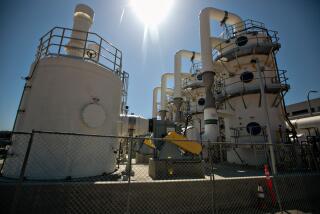Scientists Use Tadpoles to Monitor Pollutants : Environment: Microscopic organisms give a quick study of how contaminants affect aquatic life. An Army lab will use the new technology to clean up military sites.
- Share via
FREDERICK, Md. — A peek through a microscope might reveal a young tadpole without eyes or another with one eye. Others have two tails, enlarged heads or blisters and bubbles on their bodies.
It’s a microscopic freak show inside an Army laboratory that is studying how chemicals and other pollutants affect the development of aquatic life.
Instead of relying on expensive, longer-term studies of laboratory rats or other mammals, these scientists are putting tiny frog embryos and other test organisms in water tainted with pollutants. Within a few days, they can monitor them for abnormalities that would signal acute or chronic toxicity.
“They may have abnormal bends in their tails. There may be abnormalities of their internal organs, like the heart or intestines. Some of them are pretty messed up,” said Robert Finch, a research toxicologist at the U.S. Army Biomedical Research and Development Laboratory.
The new technology under study at Ft. Detrick here, where the Army conducts medical research, is aimed at helping assess the long-term effects of chemicals on the environment, particularly at contaminated U.S. Army sites.
The technology is being field-tested at Aberdeen Proving Ground, a 75-year-old weapons testing and research center, which is trying to clean up old waste dumps.
However, Finch said the technology has applications beyond the military. “It has a universal application. It could work in any contaminated waste site. It could be used in an industrial context,” he said.
“Most toxicologists have been used to working with warm, fuzzy rabbits, mice and rats,” he said. “There is the animal rights issue and also, it’s extremely expensive to run mammalian tests.”
The studies with such organisms as frog embryos cost tens of thousands of dollars less than working with rats or mice, he noted.
The Army began the research six or seven years ago when it realized it had serious environmental problems at such sites as Aberdeen, also in Maryland, and the Rocky Mountain Arsenal in Colorado, but did not have a good way of assessing how the contamination might be affecting biological life.
Traditionally, chemists have analyzed water to get an idea of what contaminants are in it, but seldom is ground water tainted with just one or two chemicals, he said.
“It’s usually a big witch’s brew ranging from chlorinated hydrocarbon solvents like TCE to leftover chemical weapons agents,” Finch said. “The bottom line is you’re dealing with a complex mixture of chemicals.
“Not only are you unable to identify all the chemicals present, you don’t have any information on how it’s affecting biological life.”
By using species like the South African clawed frog, which develop from an early-stage embryo to a swimming tadpole in 96 hours, scientists can learn how toxic water affects development.
They can learn whether the frogs and other aquatic organisms develop tumors; exhibit behavioral changes, such as swimming in circles; suffer genetic damage, or have problems with their immune and reproductive systems, he said.
“In the adult frog, does exposure to a certain chemical cause problems with sperm? In the female, would it affect egg production or ovulation?” Finch asked.
Work at the lab is focused on exposing the organisms to toxic chemicals that already have been studied on rats and mice.
“The hope is that once we validate it, we can take this out to the field,” he said.
In April, the Army unveiled a new $2-million water-testing laboratory on wheels that will use this new technology to help scientists examine contamination problems at military cleanup sites.
Researchers in the three-trailer laboratory will be able to expose the test organisms--such as the frog embryos, fish, water fleas or algae--to contaminated water and without delay monitor its effect.
The mobile research lab’s first mission will be at Aberdeen where the trailers will be testing water for about three to five years, according to Hank Gardner, chief of the research methods branch at Ft. Detrick.
However, field trials using the new technology already are under way at Aberdeen where there is concern that contaminated ground water is seeping into nearby bodies of water.
Another three-trailer laboratory being constructed likely will be sent to the Rocky Mountain Arsenal to aid cleanup efforts there. The arsenal was operated by the Army and Shell Oil Co. for 42 years beginning in the 1940s as a production site of nerve gas, pesticides and other chemicals. It’s recognized as one of the nation’s worst hazardous waste sites.






